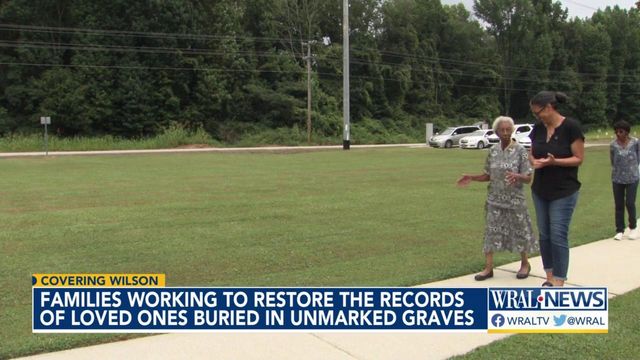Erased but not forgotten: Wilson families work to restore records of loved ones buried in unmarked graves
Land cleared along Lane Street in Wilson could easily be mistaken for a soccer field or park.
However, beneath the grass lies Vick Cemetery, the public cemetery for Black people in the city from 1913 to the 1960s.
“It’s the only cemetery we had back then at that time,” said Henrietta McIntosh.
McIntosh’s family tree is rooted in the resting place at 2000 Lane St. Southeast. As a little girl in the 1930s, McIntosh remembers the family trips to Vick Cemetery to honor loved ones lost.
“My father for sure, and then, I have aunts and uncles buried out here,” McIntosh said. “It was such a nice place, a sacred place. There were tombstones, beautiful tombstones all over the place, [and] flowers.”
McIntosh, 96, holds on to those memories because the history you could read on headstones is erased.
The city neglected Vick Cemetery for decades. It became overgrown, and in 1994, the city cleared the land and removed the headstones.
What happened to the headstones is a mystery.
“It’s just sad to not even know where your loved one’s buried,” she said. “You’ve got no evidence of where they were or where they could have been or what.”
One of the few visible reminders left on this land is a concrete top of an exposed vault. The city of Wilson kept no burial records for its Black cemetery.
The city put up a single monument with a plaque: “beneath the Earth and sod rest those Wilson citizens known but to God.”
Lisa Henderson, a Wilson native who also has family buried at Vick Cemetery, started the Lane Street Project to protect and preserve the sacred ground.
“There’s nothing really we can do about that, but we can tell the truth about what happened here and we can honor this space,” Henderson said of how the city handled the cemetery. “When I think about the abuse it has been subjected to, it’s both hurtful and it’s angering.”
Henderson got the city to hire an archeology team to survey what's beneath the soil here. What they found is startling. They used ground-penetrating radar and produced a report that reveal 4,224 probable graves. The total is nearly three times more than anyone thought.
“It was mind blowing,” said Wilson Councilwoman Gillettia Morgan. “I said, ‘Oh, my God. That many people lie down there.’”
Morgan remembers the cleanup that cleared the cemetery grounds of its grave markers.
WRAL News asked Morgan if the city made a mistake.
“I think it was a mistake,” Morgan said. “Every life matters, and when you go into internment, you need to be laid to rest with dignity.”
Morgan would like to see the city put up signs about the history here and a fence to protect the grounds.
“We want to make a statement with this,” Morgan said.
However, a statement threatens to disturb the graves again.
More than 100 orange stakes mark burial sites almost to the edge of the street where a fence would go. Utility poles already puncture the cemetery grounds.
“We’re in the process of righting the wrong,” Morgan said. “We just can’t fix everything that went wrong. We can start from here and move forward.”
WRAL News asked McIntosh what she hopes the city does to the site. She hopes the hallowed ground returns to its rightful place
“Well, I would hope they come out here and try to show some evidence of what it was,” McIntosh said. “It’s important to know our history, the African American history because we don’t see no history here."












